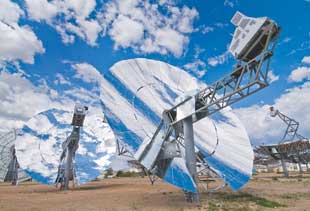Stirling Energy Systems (SES) and Tessera Solar have unveiled new solar power collection dishes they have developed with the help of engineers at Sandia National Laboratories’ National Solar Thermal Test Facility (NSTTF).
Sandia’s concentrating solar-thermal power (CSP) team has been working closely with SES over the past five years to improve the design and operation of the company's earlier system. Called SunCatchers, the new dishes will be commercially deployed in 2010.
The modular CSP SunCatcher uses precision mirrors attached to a parabolic dish to focus the sun's rays onto a receiver, which transmits the heat to a Stirling engine. The engine is a sealed system filled with hydrogen. As the gas heats and cools, its pressure rises and falls. The change in pressure drives the piston inside the engine, producing mechanical power, which in turn drives a generator and makes electricity.
The new SunCatcher is about 5,000lb lighter than the original, is round instead of rectangular to allow for more efficient use of steel, has improved optics, and consists of 60 per cent fewer engine parts. The revised design also has fewer mirrors – 40 instead of 80. The reflective mirrors, made using automobile manufacturing techniques, are formed into a parabolic shape using stamped sheet metal similar to the bonnet of a car.
Tessera Solar, the developer and operator of large-scale solar projects using the SunCatcher technology and sister company of SES, is to build a 60-unit plant in either Arizona or California that will generate 1.5MW by the end of the year.

The proprietary solar dish technology will then be deployed to develop two of the world’s largest solar-generating plants in southern California with San Diego Gas & Electric in the Imperial Valley and Southern California Edison in the Mojave Desert, in addition to a recently announced project with CPS Energy in west Texas. The projects are expected to produce 1,000MW by the end of 2012.
Last year, one of the original SunCatchers set a new solar-to-grid system conversion efficiency record by achieving a 31.25 per cent net efficiency rate, toppling the old 1984 record of 29.4 per cent.




Swiss geoengineering start-up targets methane removal
No mention whatsoever about the effect of increased methane levels/iron chloride in the ocean on the pH and chemical properties of the ocean - are we...